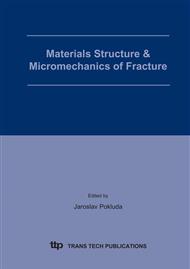p.343
p.347
p.351
p.355
p.359
p.363
p.367
p.371
p.375
Influence of Inclusions on Fatigue Characteristics of Non-Combustible Mg Alloy
Abstract:
It is common knowledge that Mg is very light and high specific strength material. But there is a problem that Mg alloy easily burns during its machining, because the ignition point of Mg is 700K.[1] The ignition point of new Mg alloy to which Ca is added is about 1000K. This new Mg alloy is called non-combustible Mg alloy. As a result, many inclusions exist in Mg alloy. Then, fatigue test was carried out and gave evidence that inclusions have an effect on the fatigue strength. Then relationships between size of inclusions and fatigue limit were drawn. Therefore, the fatigue limit can be predicted by estimating the maximum inclusion size. The method of estimating the maximum inclusion size is “Estimation for particle size distribution in materials“[2] .
Info:
Periodical:
Pages:
359-362
Citation:
Online since:
April 2005
Authors:
Keywords:
Price:
Сopyright:
© 2005 Trans Tech Publications Ltd. All Rights Reserved
Share:
Citation:


